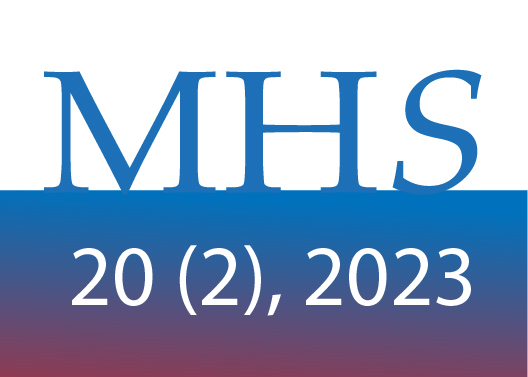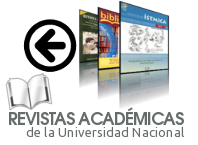Physical Activity in School Recess: Measurements of Physical Activity and the Perspective of School Children from Educational Centers in Urban and Rural Areas
DOI:
https://doi.org/10.15359/mhs.20-2.2Keywords:
physical activity, recess, school, perception, playAbstract
Objective: This study aimed to examine the number of active students and sedentary behaviors, as well as their perceptions of motivation and barriers that prevent the practice of physical activity during recess in rural and urban schools in the province of Heredia, Costa Rica.
Methodology: A mixed research study was conducted using the SOPLAY instrument to measure and classify the type of physical activity. In addition, focus groups were held with selected schoolchildren; they were asked about their perception of barriers and motivation to engage in physical activity. The population studied was schoolchildren between 7 and 12 years old enrolled in urban and rural public schools in the province of Heredia.
Results: Among the results obtained, statistically significant differences were found. Regarding moderate physical activity (MPA), urban school students were more active than those from rural schools. Concerning vigorous physical activity (VPA), the statistically significant differences were only between the sexes, being greater in boys than in girls. Among the main reasons for the motivation to do physical activity were learning, playing, and socializing. The main barriers the children mentioned were space, the dangers of infrastructure, and violence or bullying.
Discussion: It is recommended to invest in improving the infrastructure of schools, disposing of waste materials that put children’s safety at risk so that they can have more room to play, in addition to the acquisition of materials to provide more options and promote the realization of physical activity during recess.
References
Alcaraz-Cantó, R. y Ruíz-Pérez, L. (2005). Comportamiento Motor Espontáneo en el Patio de Recreo Escolar: Análisis de las diferencias por género en la ocupación del espacio durante el recreo escolar. Revista Internacional de Ciencias del Deporte, 1, 28-45. https://doi.org/doi:10.5232/ricyde2005.00103
Al-Hazzaa, H. M., Abahussain, N. A., Al-Sobayel, H. I., Qahwaji, D. M. y Musaiger, A. O. (2011). Physical activity, sedentary behaviors and dietary habits among Saudi adolescents relative to age, gender and region. International Journal of Behavioral Nutrition and Physical Activity, 8. https://doi.org/10.1186/1479-5868-8-140
Álvarez-Bogantes, C. (2016). Entendiendo los factores que determinan la actividad física en el entorno escolar desde la perspectiva de los niños y niñas. Revista MHSalud, 13(1), 1659-97. https://doi.org/10.15359/mhs.13-1.2
Álvarez-Bogantes, C., Villalobos-Víquez, G. y Vargas-Tenorio, J. (2018). Determinación de la actividad física en el recreo escolar: combinando mediciones de actividad física y la perspectiva estudiantil de actividad física y la perspectiva estudiantil. Revista MHSalud, 14(2), 1-13. https://doi.org/https://doi.org/10.15359/mhs.14-2.4
Álvarez, C. E., Herrera-Monge, M. F., Herrera-González, E., Villalobos-Víquez, G. y Araya-Vargas, G. A. (2020). Sobrepeso, obesidad, niveles de actividad física y autoestima de la niñez centroamericana: un análisis comparativo entre países (Overweight, obesity, physical activity levels, and self-esteem in Central American children: comparative analysis between countries). Retos, 37, 238-246. https://doi.org/10.47197/retos.v37i37.71680
Arias, A. E. (2014). Niveles de actividad física de niños y adolescentes durante el descanso en la escuela, un estudio observacional con el uso de SOPLAY. Revista Educación Física y Deporte, 33(1), 175-191. https://doi.org/10.17533/udea.efyd.v33n1a10
Arias-Sandoval, L. (2009). Una mirada al fenómeno de la violencia escolar en Costa Rica. Revista Electrónica Educare, 13(1), 41-51. https://doi.org/10.15359/ree.13-1.4
Baile, J., Raich, R. y Garrido, E. (2003). Evaluación de Insatisfacción Corporal en adolescentes: Efecto de la forma de administración de una escala. Anales de Psicología, 19(2), 187-192. https://www.um.es/analesps/v19/v19_2/02-19_2.pdf
Bingham, D. D., Costa, S., Hinkley, T., Shire, K. A., Clemes, S. A. y Barber, S. E. (2016). Physical Activity during the Early Years: A Systematic Review of Correlates and Determinants. American Journal of Preventive Medicine, 51(3), 384-402. https://doi.org/10.1016/j.amepre.2016.04.022
Biddle, S. J. H., Gorely, T. y Stensel, D. J. (2004). Health-Enhancing Physical Activity and Sedentary Behavior in Children and Adolescents. Journal of Sports Science, 22, 679-701. https://doi.org/10.1080/02640410410001712412
Black, I. E., Menzel, N. N. y Bungum, T. J. (2016). The Relationship Among Playground Areas and Physical Activity Levels in Children. Journal of Pediatric Health Care, 29(2), 156-168. https://doi.org/10.1016/j.amepre.2016.04.022doi.org/10.1016/j.pedhc.2014.10.001
Chin, J. J. y Ludwig, D. (2013). Increasing children’s physical activity during school recess periods. American Journal of Public Health, 103(7), 1229-1234. https://doi.org/10.2105/AJPH.2012.301132
Escalante, Y., Backx, K., Saavedra, J., García, A. y Domínguez, A. (2011). Relación entre actividad física diaria, actividad física en el patio escolar, edad y sexo en escolares de educación primaria. Revista Española Salud Pública, 85, 481-489. https://scielo.isciii.es/pdf/resp/v85n5/07_original_breve1.pdf
Espejo, T., Zurita, F., Chacón, R., Castro, M., Martínez-Martínez, A., y Pérez-Cortés, A. J. (2017). Actividad física y autoconcepto: dos factores de estudio en adolescentes de zona rural. Revista Iberoamericana de Psicología del Ejercicio y el Deporte, 13(2), 203-210. https://doi.org/10.1017/CBO9781107415324.004
Grant, V., Brown, B., Swaney, G., Hollist, D., Harris, K. J., Noonan, C. W. y Gaskill, S. (2015). Community-identified strategies to increase physical activity during elementary school recess on an American Indian reservation: A pilot study. Preventive Medicine Reports, 2, 658-63. https://doi.org/10.1016/j.pmedr.2015.08.012
Gutiérrez-Zornoza, M., Rodríguez-Martín, B., Martínez-Andrés, M. y García-López, Ú. (2014). Percepción del entorno para la práctica de actividad física en escolares de la provincia de Cuenca, España. Gaceta Sanitaria, 28(1), 34-40. https://doi.org/10.1016/j.gaceta.2013.04.011
Hamzeh, M. A. (2007). Deveiling narrative inquiry: Entry and agency in body stories of Muslim girls. (Tesis de doctorado). Universidad del Estado de Nuevo México.
Herrera-Monge, M. F., Álvarez-Bogantes, C., Sánchez-Ureña, B., Herrera-González, E., Villalobos-Víquez, G. y Vargas Tenorio, J. (2019). Análisis de sobrepeso y obesidad, niveles de actividad física y autoestima en la niñez del II ciclo escolar del cantón central de Heredia, Costa Rica. Población y Salud en Mesoamérica, 17(1). https://doi.org/10.15517/psm.v17i1.35323
Joens-Matre, R., Gregory, W., Calabro, M., Russell, D., Nicklay, E. y Hensley, L. (2008). Rural-Urban Differences in Physical Activity, Physical Fitness, and Overweight Prevalence of Children. The Journal of Rural Health, 24(1), 49-54. https://doi.org/10.1111/j.1748-0361.2008.00136.x
Junta de Castilla y León. (2004). Actividad física y salud en educación primaria. Junta de Castilla y León. www.saludcastillayleon.es/sanidad/cm/sanidad/images?idMmedia=76865
Mckenzie, T. y Cohen, D. (2006). System for Observing Play and Leisure Activity in Youth Description and Procedures Manual. Sciences-New York, 1-8. http://dx.doi.org/10.13072/midss.132
McKenzie, T. L., Sallis, J. F. y Nader, P. R. (1991). SOFIT: System for observing fitness instruction time. Journal of Teaching in Physical Education, 11(2), 195-205. https://doi.org/10.1123/jtpe.11.2.195
McKenzie, T., Marshall, S., Sallis, J. y Conway, T. (2000). Leisure-time physical activity in school environments: An observational study using SOPLAY. Preventive Medicine, 30(1), 70-77. https://doi.org/10.1006/pmed.1999.0591
Ministerio de Educación. (2016). Censo Escolar Peso/Talla 2016. Costa Rica. http://www.mep.go.cr/sites/default/files/page/adjuntos/informe-ejecutivo-censo-escolar-peso-cortofinal.pdf
Montil Jiménez, M. (2004). Actividad física en población infantil. (Tesis de doctorado). Universidad Politécnica de Madrid.
Moreno, J. A., Martínez, C. y Alonso, N. (2006). Actitudes hacia la práctica físico-deportiva según el sexo del practicante. Revista Internacional de Ciencias del Deporte, 3(2), 20-43. http://www.cafyd.com/REVISTA/art2n3a06.pdf
Myers, T. J. (2008). School-Based physical activity interventions: A meta-analysis. (Tesis de postgrado). Iowa State University, Iowa.
Obando, V. M. (2016). Sobrepeso y obesidad, nivel de actividad física y percepción de la autoimagen de niños y niñas de I y II ciclo escolar: variaciones presentadas durante el año lectivo y su relación con el nivel socioeconómico, composición del núcleo familiar y nivel educativo de los padres. (Tesis de postgrado). Universidad Nacional, Costa Rica.
Olivares C., S., Bustos Z., N., Lera M., L. y Zelada, M. E. (2007). Estado nutricional, consumo de alimentos y actividad física en escolares mujeres de diferente nivel socioeconómico de Santiago de Chile. Revista Médica de Chile, 135(1), 71-78. https://doi.org/10.4067/s0034-98872007000100010
Okuda-Benavides, C. y Gómez-Restrepo, M. (2005). Métodos en investigación cualitativa: triangulación. Revista Colombiana de Psiquiatría, 34(1), 118-124. http://www.scielo.org.co/pdf/rcp/v34n1/v34n1a08.pdf
Organización Mundial de la Salud. (2020ª). Obesidad y sobrepeso. https://www.who.int/es/news-room/fact-sheets/detail/obesity-and-overweight
Organización Mundial de la Salud. (2020b). Estrategia mundial sobre régimen alimentario, actividad física y salud. https://www.who.int/dietphysicalactivity/factsheet_young_people/es/
Organización Mundial de la Salud. (2017). Actividad física. http://www.who.int/mediacentre/factsheets/fs385/es/
Pawlowski, C. S., Andersen, H. B., Troelsen, J. y Schipperijn, J. (2016). Children’s physical activity behavior during school recess: a pilot study using GPS, accelerometer, participant observation, and go-along interview. Plos One, 11(2), 1-18. https://doi.org/10.1371/journal.pone.0148786
Pawlowski, C., Tjørnhøj-Thomsen, T., Shipperijn, J. y Troelsen, J. (2014). Barriers for Recess Physical Activity: A Gender Specific Focus Group Exploration. BMC Public Health, 14, 3-10. https:// doi.org/10.1186/1471-2458-14-639
Pyles, A. (2016). Availability and quality of physical activity resources throughout rural and urban communities in Comanche. (Tesis de postgrado). Bradley University, Illinois.
Ridgers, N. D., Stratton, G. y Fairclough, S. J. (2006). Physical activity levels of Hungarian children during school recess. Sports Medicine, 36(4), 359-37. https://doi.org/10.1016/j.ypmed.2009.08.008
Serra-Puyal, J. R. S. (2014). Análisis de la práctica de actividad física durante el recreo escolar en adolescentes de la provincia de Huesca. Archivos de Medicina del Deporte, 31(4), 257-262. http://archivosdemedicinadeldeporte.com/articulos/upload/or04_162.pdf
Torrico-Linares, E., Santín-Vilariño, C., Andrés-Villas, M., Menéndez-Álvarez-Dardet, S. y López-López, M. (2002). El modelo ecológico de Bronfrenbrenner como marco teórico de la Psicooncología. Anales de Psicología, 18(1), 45-59. https://www.um.es/analesps/v18/v18_1/03-18_1.pdf
Van Stralen, M. M., Yildirim, M., Wulp, A., te Velde, S. J., Verloigne, M., Doessegger, A., … Chinapaw, M. J. M. (2014). Measured sedentary time and physical activity during the school day of European 10- to 12-year-old children: The ENERGY project. Journal of Science and Medicine in Sport, 17(2), 201-206. https://doi.org/10.1016/j.jsams.2013.04.019
Vicente-Rodríguez, G., Benito, P. J., Casajús, J. A, Ara, I., Aznar, S., Castillo, M. J., ... Valtueña, J. (2016). Actividad física, ejercicio y deporte en la lucha contra la obesidad infantil y juvenil. Nutrición Hospitalaria, 33(Supl. 9), 1-21. https://dx.doi.org/10.20960/nh.828
Vidal-Conti, J. (2016). Identificación de predictores de actividad física en escolares según el modelo socio-ecológico mediante un análisis multifactorial. Cultura, Ciencia y Deporte, 11(31), 51-59. https://doi.org/10.12800/ccd.v11i31.642
Vílchez, S., Sánchez, I. y Abril, S. (2011). Abandono de la actividad física según el género. EFDeportes.com, Revista Digital, 16(161). http://www.efdeportes.com/efd161/abandono-de-la-actividad-fisica-segun-el-genero.htm
Vuchenich, M. (2010). Effects of a before school physical activity program on physical activity and on-task behavior in elementary school-aged children. (Tesis de postgrado). East Carolina University, East Carolina.
Published
How to Cite
Issue
Section
License
General conditions
MHSalud: Journal in Human Movement Sciences and Health by the Universidad Nacional is cover under a Creative Commons Atribución-NoComercial-SinDerivadas 3.0 Costa Rica license.
The journal is hosted in open access repositories such as the Institutional Repository of the Universidad Nacional, the Kimuk Repository of Costa Rica and La Referencia.
The editorial source of the journal must be recognized. Use the doi identifier for this purpose.
Self-archiving policy: The journal allows the self-archiving of the articles in their peer-reviewed version, edited and approved by the Editorial Board of the Journal to be available in Open Access through the Internet. More information in the following link: https://v2.sherpa.ac.uk/id/publication/25815



















